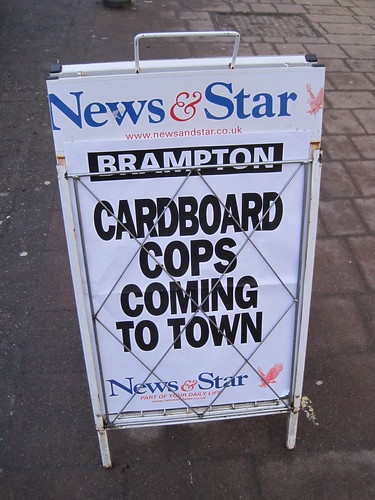I had a change to have a conversation with somebody who fits the criteria of an 'educated adult' and they gave me some feedback on what i thought was my finished first newspaper page.
This is the front page of my newspaper which i believed was finished, but actually i found out isn't after i spoke to a member of my focus group. I have treated this first version of my newspaper as a first draft.
I was given a list of improvements which i will make to my newspaper page. I understand that i am going to make changes to my newspaper with information from just one person, however this person has experience in newspapers and often reads them, therefore i think they are a valuable source.
Here is a list of the information i was given to improve my newspaper and the changes i am planning to make:
- To have a more overall local focus. This is throughout the subject of the articles, photos etc.
- Move the QR code so that the headline title isn't so separated up.
- For the artist article, have a photo of a young person on the second page. An educated and cultured audience would be interested in up and coming talent.
- For the days out article, call it 'Cultural Days Out', 'instead of fun family days out'. This is because an educated audience would want their children to learn while having fun. Also for this article, i should have a picture of the Norwich castle because it is more local and also more educational and cultural. i have currently got a theme park photo, however this is less middle-class than a photo of a bit of history.
- Instead of Johnny Depp having a new film out, i should write about how Stephen Fry, known to be from this area and is a very intelligent individual and how he celebrates film (he also owns a production company) by writing a book about the history of film. Also mention that he has got a book signing coming up. Would i be able to get a suitable photo?
- For the pension article could have a sub-title saying that 2 Norfolk professionals have their say - my target audience are likely to be of people who have a profession, therefore feel like the article is relevant to them, relatable and interesting.
- The headline should have a bit of text which says there is a debate further in the paper, this also means that i will have to write a few opinions of a couple of people on the matter. I will probably do this is bullet points so that it is a quick, simple and direct read.
- Add a price bar code - how can my newspaper be bought if it doesn't have one?
- On the front page, next to the pension article, have information on a competition which readers can be involved in. I do not have to write about this competition. I have decided that the competition will be about winning some seats for Cinema City - a cinema which is known to be fairly expensive, middle-class and feature arty, alternate films - which i am sure my educated adult audience would be interested in.
- The person who i asked also thought i should change the price of my newspaper from £1.10, to just £1. This is because it makes my newspaper easier to buy, more convenient as there is less change involved when purchasing especially if it will be sold on the street and it makes my newspaper more able to be picked up and bought - therefore supporting the idea that my educated adult audience would have children who they have to take to school or they have to go to work themselves.
- This is quite a dramatic change. I have said all along that i want my newspaper to be of tabloid size, however, the individual i spoke to believed that having my newspaper A4 size makes it more of a portable newspaper, one which can be taken around with and layed about and also, it makes production costs lower for me. If i were to create this newspaper for real, i could consider changing this, but as this is a sample newspaper that i am making, i can afford to have it this size. Also, i think that having a small sized page will make everything a little more packed together, therefore making it lo0ok as if my newspaper is supplying a lot of information for a small price.
The person who i asked thought the colour scheme of just black and white made the newspaper look retro, taking my audience back to their youth because of its older fashioned appearance. I think that not having my newspaper in colour will also make it stand out on the shelf compared to the modern, colourful newspapers around nowadays.
So now, all i have to do is make the pages which i believe with these directions will be simple.

